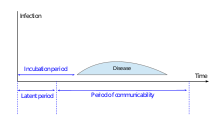Infectious period

In
When pathogens encounter a susceptible individual and enter his or her body, it is called the exposure moment, and the individual turns into a host for those pathogens. After entering a host's body (which marks the beginning of the infection process), pathogens usually require time to multiply or replicate at their favorite site in the body (for example, the Hepatitis virus multiplies in the liver). After a certain time period, the pathogens become numerous enough so that the host is now able to transmit them into the environment. This marks the end of the latent period (pre-infectious period) and simultaneously the beginning of the infectious period. As the disease becomes more severe, infectiousness increases. Meanwhile the host's body mounts immune responses to contain or eradicate the pathogens, and after a certain period of time, it may achieve that goal. The quantity of pathogens in the host's body become sufficiently low so that the host is no longer capable of transmitting the disease. This usually marks the end of the infectious period, even though for some diseases such as Ebola, the virus continues to be present in the body fluids of the survivor. By contrast, if the host's body cannot recover from a potentially deadly infection, the host will die. Even after death, the infectious period might not be over. For example, the dead body of an individual who died of Ebola remains very infectious for up to a week.[4]
A related concept is the shedding period, which is the time interval during which a host or patient excretes the pathogenic organism through saliva, urine, feces or other bodily fluids. Shedding period usually coincides with the infectious period and used as its synonym.[2]
For viral infections,
See also
- Asymptomatic carrier
- Basic reproduction number
- Generation time
- Incubation period
- Latent period
- Serial interval
- Viral shedding
References
- ^ Mary Louise Fleming; Elizabeth Parker (2012), Introduction to Public Health, Elsevier Health Sciences, p. 396
- ^ a b Systematic review on the incubation and infectiousness/shedding period of communicable diseases in children, Stockholm: European Centre for Disease Prevention and Control, 2016, p. iv
- ^ Priscilla E. Greenwood; Luis F. Gordillo (2009), "Stochastic epidemic modeling", in Gerardo Chowell; James M. Hayman; Luís M. A. Bettencourt; Carlos Castillo-Chavez (eds.), Mathematical and Statistical Estimation Approaches in Epidemiology, Springer Science & Business Media, p. 46
- PMID 25897646.
- ^ Dave Wessner; Christine Dupont; Trevor Charles; Josh Neufeld (2020), Microbiology, John Wiley & Sons, p. 630
